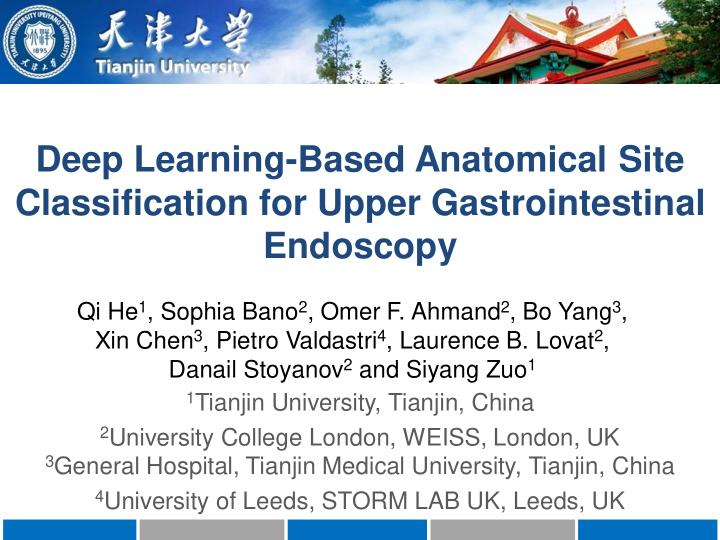



Deep Learning-Based Anatomical Site Classification for Upper Gastrointestinal Endoscopy Qi He 1 , Sophia Bano 2 , Omer F. Ahmand 2 , Bo Yang 3 , Xin Chen 3 , Pietro Valdastri 4 , Laurence B. Lovat 2 , Danail Stoyanov 2 and Siyang Zuo 1 1 Tianjin University, Tianjin, China 2 University College London, WEISS, London, UK 3 General Hospital, Tianjin Medical University, Tianjin, China 4 University of Leeds, STORM LAB UK, Leeds, UK
Background Esophagogastroduodenoscopy (EGD) Gold-standard Widely performed Potential blind spots Difficulties: Standardized photo-documentation Quality indicator Various guidelines Time-consuming [https://www.teresewinslow.com/] Need for the automatic photo-documentation method to support and efficiently improve the quality of endoscopy
Challenges Complete examination Geographical regions with higher gastric disease incidence Captured photos could construct a complete quality indicator Anatomical site classification Easily recognized from their statics appearances Cover the pre-collected image datasets as much as possible Learn from a small dataset Need for a guideline adapted with the examination procedure and classification algorithm at the same time
Endoscopy guidelines Japanese guideline [Yao, ‘13] Focuses exclusively on detailed imaging of the stomach including comprehensive multiple quadrant views of each landmark Not routinely clinically implemented outside of Japan British guideline [BSG and AUGIS, ‘ 17] [ESGE, ‘01] Includes additional important landmarks outside of the stomach Fewer images of the stomach Need for designing a new upper GI guideline that adapted to existing examination procedure.
Objectives Guideline Adapted to existing examination procedure Robust quality indicator Annotation friendly
Workflow
Design of data collection Dataset before preprocessing Image resolution: 768 x 578, 1024 x 600… Imaging mode: WL, LCI, NBI… Dataset size: 229 cases including 5661 images Dataset after preprocessing Imaging mode: WL, LCI Dataset size: 211 cases including 3704 images
Design of ROI extraction Automatic outborder eliminated Adapted to various photography situations Case average ROI extraction
Design of Anatomical annotation Anatomical classification guideline Adapted to existing British Guideline Data augmentation friendly Annotation friendly Antegrade view Retroflex view
Experimental Design Materials Four different forms of datasets Five-fold cross-validation
Experimental Design Evaluation metrics and model implementation The overall accuracy (models): F1-score (landmarks) Confusion matrix (between landmarks) Tool: PyTorch
Deep Learning-based anatomical site classification DenseNet-121 Multi-class cross-entropy loss: Data augmentation: Rotation, flipping, random value shifting, random scaling, colour jitter [Ji et al., ‘19]
Results Evaluation of the CNN models The average overall accuracy of these four models shows that DenseNet-121 gave slightly better accuracy All CNN models performed equally good that demonstrate their strong learning capability and the practicality of our anatomical classification guideline Overall accuracy (%) of five CNN models for four datasets
Results Evaluation of the guideline The proposed guideline helps the CNN model to recognise three additional landmarks (PX, MR and LB) than the British guideline. The F1-score (%) of DenseNet-121 on four datasets
Results Evaluation of the guideline The CNN model evaluated on our trimmed dataset corresponding to the British guideline (since NA, PX, MR and LB are excluded) achieved superior performance Confusion matrix for the model based on the British guideline
Results Evaluation of the guideline The performance is low for LB (class 7) since it is hard to find a reference to well recognise LB from a single image Confusion matrix for the model based on proposed guideline
Discussion Successful points Small amount of data required for training model Annotation friendly Adapted to the British examination procedure Recognize 3 more landmarks that the British guideline Enable photo-documentation of upper GI endoscopy
Discussion Issues We observe the errors from the confusion matrices Cause: No temporal information Several landmarks with similar tissue appearances are easily misclassified to each other Solution: To further improve the results, we plan to analyse EGD videos in future using 3D CNN and recurrent neural networks, which will incorporate both spatial feature representation and temporal information simultaneously
Discussion Issues Class NA was confused with the other landmarks Cause: NA and the other landmarks shared several features There is no clear boundary between blurry landmarks and NA Solution: Train a special classifier to divide the NA and the others into two classes. And then train another classifier to recognize each useful landmark.
Conclusion A modified guideline for upper GI endoscopic photo- documentation A new upper GI endoscopic dataset A complete workflow for EGD image classification
Thank you very much for your attention
Recommend
More recommend